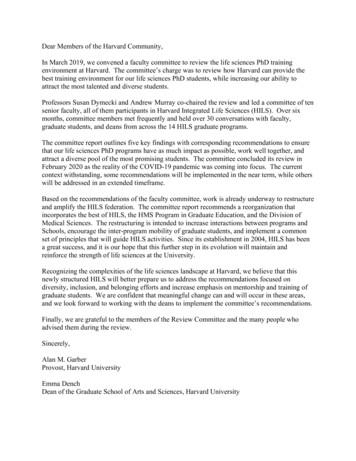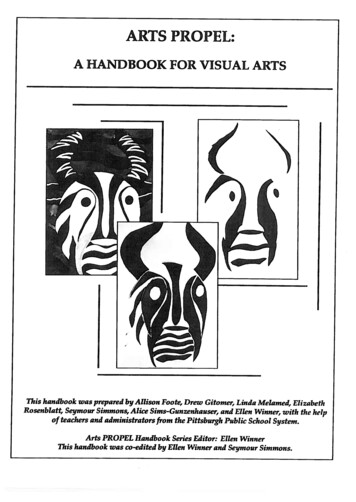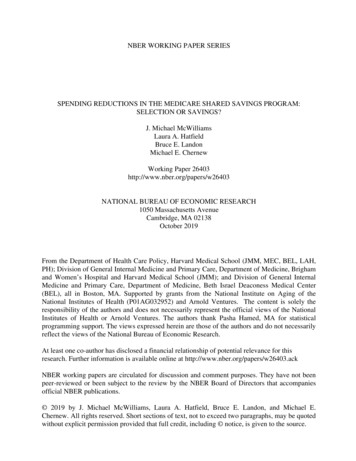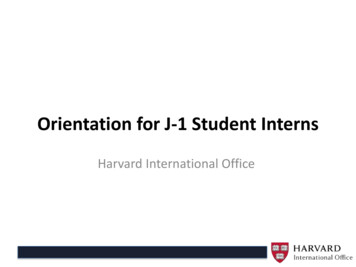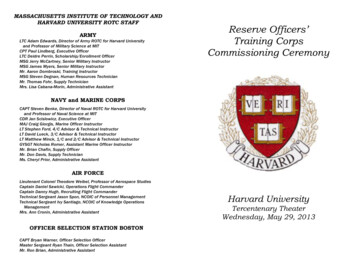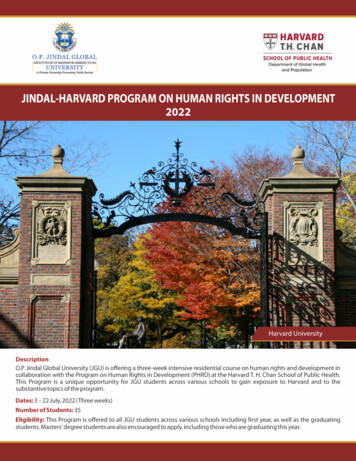
Transcription
ARTS PROPEL:A HANDBOOK FOR IMAGINATIVE WRITINGTHE WIG ON MY HEADLittle old me sitting in my highchairEating one of my favorite fruits, the apple.The strange thing is Igot a wig on my head.I don’t know howit got there but it’s there,I’m just sittingthere gigglingdon’t even know what’sgoing on around me, but there’s still asilly wig on my head.MOPWoman tall and thinWith long tangled gray hairMust turn her life upside downTo do her dutyHolding her breath while washing her hairWringing out the dirty waterThen she goes to her dutyAgainThis handbook was prepared by Roberta Camp, Steve Seidel, Dennie Wolj and RienekeZessoules, with the help of teachers and administrators from thePittsburgh Public School System.Arts PROPEL Handbook Series Editor: Ellen WinnerThis handbook was co-edited by Roberta Camp and Ellen Winner.
AcknowledgmentsMany of the materials and ideas presented here were developed in collaborationwith the Pittsburgh Public School system. We thank the supervisors, teachers, and students from Pittsburgh for their invaluable collaboration. Arts PROPEL was generouslyfunded by a grant from the Rockefeller Foundation;funds were also made available by theEducational Testing Service.We would like to acknowledge that the work described here represents a collaboration of many minds including students, teachers and administrators in Pittsburgh andCambridge, research scientists at Educational Testing Service, and educators, developmental psychologists, artists and researchers at Harvard Project Zero. The quality of thiswork is a reflection of all of the participants, who made invaluable contributions to theproject.The Pittsburgh Public SchoolsJoAnn Doran, Supervisor, EnglishJoAnne Eresh, Director of Writing and Speaking DivisionStanley Herman, Associate Superintendent, Curriculum and Program ManagementKathryn Howard, Middle School Language Arts Teacher and Writing Team CoordinatorPaul LeMahieu, Director of Research, Evaluation, and Test DevelopmentRosemary McLaughlin, Supervisor, EnglishMary Anre Mackey, Executive Assistant to the Associate Superintendent,Co-Director for Arts PROPEL in PittsburghDeborah Saltrick, Research Assistant, Division of Research, Evaluation, and Test DevelopmentMildred Tersak, Coordinating AssistantAlice Turner, Supervisor, EnglishSylvia Wade, Supervisor, Language ArtsRichard Wallace, Superintendent of SchoolsCore Research teachers:Marilyn Caidwell, William Cooper, Jerome Halpern, Rose Haverlack, Lorraine Hoag, Kathryn Howard, DianeHughes, Jean Kabbert, Denyse Littles, Daniel Macel, Aria Muha, Carolyn Olasewere, Cheryl Parshall,Cassandra Richardson, Elizabeth Sanford, Mary Ann Strachan, James Wright, Daniel Wyse, Mary CullighanWyse.Dissemination teachers:Rita Clark, Jane Gargaro, Annette Jordan, Mary Ann Rehm, Daniel Zygowski.The Boston/Cambridge Teachers’ NetworkCosette Beauregard, Rob Riordan, Geraldine Spanguolo, Joanne Walthers.1
Educational Testing ServiceDrew Gitomer, Co-Director of the Arts PROPEL ProjectRoberta CampLauren NuchowJoAn PhillipsHarvard Project ZeroHoward Gardner, Co-Director of the Arts Propel ProjectDennie Palmer Wolf, Co-Director of the Arts Propel ProjectJonathan LevyRebecca LangeSteve SeidelJoe WaltersRieneke ZessoulesOutside ConsultantsFrom Teachers and Writers Collaborative, New York: Lariy Fagin, Elizabeth Fox, Bill Logan, Julie Patton,Nancy Shapiro, Susana Tubert, and Dale Worsley.Others Formerly with the ProjectJoan NealAnn MoniotSybil CarlsonJohn GlennJohn KingsleyMary RaivelDebbie Van SlykeWe would also like to acknowledge the students from Pittsburgh, Boston and Cambridge as energetic andenthusiastic partners. Also, we thank two teachers directly cited: Carol Olasewere (Fig. 3.2, Classroominteraction with students), Jerry Halpern (Fig. 3.6, Teacher reflection).Thanks to Michelle Pointer for help in preparing this manuscript.Arts PROPEL Handbook production and design by Shirley Veenema.Copyright 7993 by Educational Testing Service and the President and Fellows of Harvard College (onbehalf of Project Zero, Harvard Graduate School of Education). All rights reserved.This handbook was produced by Harvard Project Zero and Educational Testing Service with funding fromthe Rockefeller Foundation and Educational Testing Service.2
Table of Contents1: Introductionpage 5CHAPTER 2: Domain Projects: Writing Poemspage 11CHAPTER 3: Domain Projects: Writing Scenespage 434: Iortfo liospage 71CHAPTER 5: Lessons and Implicationspage 85CHAPTER 6: Sample 7th Grade Portfoliopage 93page 1273
CHAPTER 1INTRODUCTIONAlmost daily, we hear that American students read meagerly, without inference orimagination, and that they write more like scribes and clerks than authors: woodenly,plainly, and only on demand. The following chapters present the collaborative work ofa group of teachers, students, administrators, and researchers who together, and acrossfive years, went to work changing this picture of literacy. Together, in those years, weinvestigated how writing, reading, speaking and listening could change in urbanclassrooms. We did so as a part of a much broader exploration of teaching andassessment in the arts and humanities. The project was Arts PROPEL.The outgrowth of a larger effort in the reform of school curriculum and assessmentfunded by the Rockefeller Foundation, Arts PROPEL brought educators and researchersfrom Harvard Project Zero and Educational Testing Service together with teachers,administrators, and students in the Pittsburgh Public Schools for five years of exchange.In those five years we developed and implemented classroom practices that led toalternative forms of assessment.In most English classes, students are spectators. They only look in on literature:they read it and they write essays about it. We asked ourselves what would happen ifwe were to put authorship right in the middle of the curriculum, where, for so long,reading and critical response to others’ writing have stood alone. We asked, too, whatwould happen if reading and critical response became integral parts of what it takes towrite wellas it is for adult poets or playwrights. Finally, we asked, “If students inclassrooms become authors and critics in this way, what else must change?” Notably,we realized that one way in which we respond to student workour daily and ourmore focussed and high-stakes forms of assessmentwould need to change radically.Assessment would need to become an episode of learning, not simpiy an occasion forcorrection. Assessment would need to teach students how to recognize the signs ofgood work, how to reflect on their own work, and how to take and offer good criticism.This handbook is our effort to summarize what we have learned about a kind ofliteracy based in literature and in authorship. It presents a view of the curriculum, theclassroom teaching practices, and the approaches to assessment which emerge once thewriting of literature becomes central in English classes. We begin with an introduction toauthorship literacy. We then describe the collaborative process used by teachers,supervisors, and researchers to develop classroom projects in which writing, reading,and critical responseor production, perception, and reflection on one’s own andothers’ workwere combined. In Chapter 2, we look at students engaged in writingpoetry. Also in that chapter, we take up the discussion of a key problem in assessment:developing a classroom language which focuses students’ and teachers’ attention on thecentral issues and essential understandings of a particular kind of work. In Chapter 3—————5
we look at students learning to write dramatic dialogues and then an entire scene. Inthis chapter, we take up an additional issue in assessment: the design of processes inwhich both students and teachers can become thoughtful critics of students’ writing. InChapter 4, we examine how students’ writing can be encouraged, improved, andfinally, assessed using portfolios of work not unlike the sheaves of poems, or thescripts, that authors circulate to friends, colleagues, and finally, to publishers andreaders. Here, we explore first how such portfolios can provide the basis for more thanongoing grading. Second, we discuss how classroom data, like portfolios, mightprovide schools or districts with information about how well their students write. InChapter 5, our conclusion, we draw out the lessons learned from this kind of work inwriting instruction and assessment.—Writing and Critiquing as Authors: A Point of ViewThe work that we have done was initially concerned, not with writing of all kinds,but specifically with imaginative writing. We started with imaginative writing becauseit is in inventing a world, in breaking with the plain, daily forms of language, or intrying to write in someone else’s voice, that students become intensely aware that theyare working in a medium —that the words, rhythms, pauses, and the images they evokeare much like clay or musical notes. As we continued to work with students andteachers, we recognized that if students were to become authors, and if they were togenerate writing worthy of serious assessment, they would need to be presented withcertain opportunities:o the opportunity to engage the imaginationWe believe that writing is practiced most effectively and honestly when thewriter’s imagination is engaged. In the moments when imagination is engaged,students are able to see new possibilities and to take steps toward thinking andworking as writers. Therefore, the first and essential condition for students’learning is the stimulation and engagement of their imaginations and theencouragement to write as much as possible during these periods ofengagement.o the opportunity to write as poets and playwrightsA goal of the classroom activities we developed is to encourage students to thinkas poets and playwrights. To take these first steps, students must be encouragedto write frequently, and they must be able to explore a variety of genres, not byexperiencing single episodes, but by engaging in sustained encounters with aparticular kind of writing. By investigating what it is to write for the stage incontrast to what it means to write for a poetry journal or a newspaper, studentscome to know the possibilities and particularities of playwriting, poetry, andjournalism. And by writing many dialogues, many poems, and many articles,students come to know what it means to think as a playwright, a poet, or ajournalist. It is this level of understanding that allows students to become activeand informed authors.6
o the opportunity to write for real audiencesIf we want students to be able to think as writers, then we must help them bringtheir writing to a real audience— that is, an audience beyond the classroomteacher. For it is only when a young writer finds that her work actually affectsanother person— a parent, peer, or stranger— that she can begin to understandthe power of writing as a form of communication. There is more potential in thatmoment to encourage a new writer to continue than in all of the pleas, requests,urgings, and assignments from a language arts teacher to “write more” or to“write better.” For this reason, teachers must encourage students to share theirwork with peers and to develop a sense of the community of writers and readersworking together and responding to one another’s experiences.o the opportunity to be thoughtful judges of quality in writingWriting in itself isn’t enough to ensure the development of competent writingskills. In order for students to figure out how to work toward getting better aswriters, they need to become sophisticated judges of quality in writing. One wayto nurture the ability to make discriminations about quality is through frequentand very open talk about different kinds of writing and writing on differentlevels of accomplishment. Students must also be encouraged to understand whatmakes one piece of writing effective and another tedious. Discussions of intentand effect, of the distinctive properties of different genres, and of differences inreaction and taste can lead toward deeper and stronger capacities fordiscrimination in young readers and writers. These discussions also provide acritical foundation for reflection and self-assessment.O the opportunity to develop reflection as a habit of mindThe ability to tackle the complex craft of writing thoughtfully grows out ofstudents’ capacity to judge and refine their efforts before, during, and after theyhave written. Students’ ability to confront the challenges of writing— tounderstand their work as it changes over time, to build on their strengths, to seenew possibilities and challenges in their work— depends on their capacity tolook carefully at their work and form new insights and ideas about themselvesas writers. As they continue to write, students develop their abilities to judgeand their capacity to enhance and reveal the best of their knowledge andunderstanding. In this respect, reflection is an essential tool for learning and anintegral part of students’ work as writers.O the opportunity to reviseAs students learn to become better judges of quality in writing, they need topractice returning to “finished work” to see what else can be done to strengthenit. Student writers’ ability to hear, understand, and work with the responses oftheir colleagues is crucial to their success in revising their work and improvingas writers. When students learn to respond to one another’s writing in this way,their writing process begins to parallel the “real world” processes of poetsreading and revising their poems, and of playwrights drawing on directors’,actors’, and audience responses to “overhaul” and “fine-tune” their plays.7
In thinking about authorship for students, we took on an additional responsibility:that of creating deliberate sequences of activities that would model the way in whichexperienced writers move from one challenge to the next, pursuing a line of thought,technique, or theme. Thus, the poetry projects form a sequence: students begin with theapparently simple task of making a poem based on a list, then move on to the moreopen-ended task of creating a poem where mystery and power reside. Similarly, in thedrama projects, students begin with dialogue and move to scenes. Finally, building ontheir experience in the poetry and drama projects, students engage in the larger work ofcreating a portfolio of their writing.Thinking Through AssessmentEach of the types of work described herethe poetry and playwriting projectsand the formation of a portfoliohighlights a particular issue in assessment,underscoring how complex the conduct of good assessment is. In the poetry work,teachers and students worked together on one ingredient in good assessment: thecreation and application of a shared vocabulary for responding to and judging studentpoems. In the drama sequence, two other ingredients came to the fore: teachingstudents to be wise critics of their own work and helping teachers to become acuteobservers of student development.——We argue that only with a basis in this prior assessment work does it makes senseto form and judge larger collections of student work, or portfolios. In constructingportfolios of writing, students must make wise selections and teachers must draw on anestablished common language for thinking about quality in poems, scenes, or otherforms of writing. However, judging and responding to portfolios takes the work ofassessment several steps further. It involves establishing common dimensions forjudging many kinds of writing, and common expectations, or standards of achievement,for students of different ages. Thus, as we discuss assessment in the context of poetry,playwriting, and portfolios, we present one view of how a community of teachers andoutside readers can move steadily and thoughtfully towards fair, demanding, andbroad judgments of student writing.Collaborative Development of Teaching and Assessment ActivitiesTeachers, supervisors, and researchers contributed equally to the development ofthe teaching and assessment activities we will describe. The first ideas for a project wereoften sketched out by PROPEL researchers drawing on what they had observed orknew to be successful in language arts classrooms. The projects then entered a cycle ofdevelopment in which each member of the team contributed different kinds ofexpertise. In this cycle, the entire group of teachers, administrators, and researchersdiscussed the initial ideas, researchers refined them, teachers tried out the projectactivities in their classrooms, then reported on the experience and brought forwardexamples of student work for examination by the rest of the team. The discussions ofteachers’ and students’ experience and of the student work samples led to furtherrevisions and refinements, which in turn were tried out in classrooms, and the resultantstudent work was examined. Proceeding in this way, we were able to discover which8
activities required additional support for students and which needed to be modified.This cycle of development resulted in domain projects in which students arechallenged to address concepts central to poetry writing and playwriting. But it hadbenefits beyond the design of specific domain projects. As a result of their involvementin discussing and reshaping the domain projects, teachers were fully aware of thepurposes of the activities and therefore alert to possibilities for adaptation to theparticular circumstances of their classrooms. Because their supervisors had been part ofthe discussions and were clearly supportive of their efforts, teachers felt free to take onthe risks presented by the domain projects. In time, teachers came to see themselves asfull-fledged members of the research and development team. They became advocatesfor the ideas and approaches represented by the domain projects as they described themto their colleagues through in-service presentations and informal discussions.The cycle of development also had a second wave of benefits. In effect, it resultedin an important fusion between teaching, learning, and assessment. All too frequently,student learning is assessed with unit tests or standardized instruments that arediscontinuous with the materials and issues that have been central to classroomdiscussion and individual work. PROPEL writing teachers, administrators, andresearchers were all involved in the design of instruction, and could see how dailyforms of evaluation amplified student understanding. We thus moved jointly to findforms of assessment that acknowledged the interplay of reading, writing, and reflectionand that were rich enough to capture students’ grasp of writing processes as well astheir final products.How To Use This HandbookThe materials in this handbook are stories and possibilities, not recipes.Our hope is to present core issues in teaching and assessment, without inany sense prescribing either the particular projects we created, or theparticular portfolio process that we evolved. Each of the different chapterscontains materials from several classrooms, and where possible we havepointed out ways in which teachers have used the broad structuraloutlines of domain projects or portfolios to inform a sequence of teaching,learning, and assessment that reflects their own classroom approach.9
0T
CHAPTER 2DOMAIN PROJECTS: WRITTNG POEMSPoems and their making provided the initial opportunity for developing in-depth,long-term domain projects in which students could become authors, engaging directlywith the demands and techniques of a specific kind of writing, and learning to makereflection and assessment part of their writing process.Poetry is often a short, and unloved, stop in the language arts curriculum. Manylanguage arts teachers, even those who teach poetry writing, have had little experienceteaching poetry writing and find it hard, if not impossible, or threatening, to evaluatestudents’ poems. In addition, few teachers have the time or resources to locate andbecome acquainted with poems written by major contemporary poets and accessible tomiddle school and high school students. But the brevity and immediacy of such poems—the opportunity to transform or to see into a phrase—offers possibilities forexperiences of authorship that should not be ignored.At the same time that we worked on these initial poetry domain projects, we weredeveloping models for bringing together the processes of reading and writing, forfusing instruction and assessment, and for collaborations among teachers,administrators, outside researchers and students. We were also, in combination withparallel efforts in visual arts and music, defining the key features of Arts PROPELdomain projects.FIVE KEY IDEAS ABOUT DOMAIN PROJECTS1. Domain Projects are composed of a series of interrelated activities thatemphasize process, require revision and reflection, and are accessible tostudents with various levels of technical skills.2. Domain projects are open-ended projects with multiple solutions. They invitestudents to discover and invent their own solutions, and to explore others’solutions.3. Domain projects stress production as the central activity: reflective andperceptual activities grow out of, and feed back into, the creative process.4. Domain project work is assessed not only for the finished product, but also forthe learning, growth, and increased understanding that has occurred.5. Domain projects pose problems that stimulate students to increase their role indefining their own problems to pursue.11
An Introduction to Poetry: From Lists to MysteriesThe PROPEL poetry materials include two domain projects focusing on techniquesthat are central to poetry writing but open to beginning writers; they are deliberately“just across the line” from the language and forms that students use daily. The firstproject introduces students to the technique of using lists or catalogues to structure apoem. The second helps students to understand the ways in which a writer can create asense of awe or mystery in a poem by describing ordinary objects and experiences inunforeseen, magical, even startling, ways. The two domain projects complement oneanother; the first helps students to see the connections between poetry and the rhythmsand patterns of everyday language, whereas the second emphasizes the qualities oflanguage and perception that set poetry apart from ordinary uses of words.Each project consists of a series of integrated, cumulative activities spanningseveral class periods. In some classrooms a project may be completed in as little as aweek, and in others in as much as three weeks, but most teachers allow about twoweeks for each of the poetry domain projects. The point in each is to provide studentswith a sense of the process of writing a poem. This process, we believe, involves muchmore than inspiration and inscription. It extends even beyond revision and recopying.In fact, both domain projects insist that the making of a poem involves production,perception, and reflection. Or put differently, poetry-making involves the work ofwriting, reading what others have written, and thinking critically. Consequently bothdomain projects involve students in activities like drafting and revising, browsing andreading aloud, and evaluating their own and other students’ writing.Writing a List PoemTo draw students’ attention away from the “rhymes and roses” caricature ofpoetry, and to attract them to the metaphorical and inventive work of writing poems,we began by asking them to create what we termed “a list poem,” in which thecontents, the order, and the wording of an ordinary sequence can open up the lyrical,surprising, and non-literal possibilities of language.In working with the list poem, students begin by reading several examples ofpublished poems where the writer uses a listing or catalogue technique. They read suchpoems as Nikki Giovanni’s “Knoxville, Tennessee,” Carl Sandburg’s “Arithmetic,”Langston Hughes’ “April Rain Song,” James Tate’s “First Lesson,” or Susan Astor’s“Night Rise.” Students also read some examples of list poems written by other students.In class and together, they examine closely the poet’s use of the listing or cataloguetechnique in one or more of the poems, marking up a copy of one of these poems toindicate more specifically how the technique shapes the poem (FIGURE 2.1).The dass may work all together, with the teacher marking up an overheadtransparency of the poem to reflect decisions made in the discussion, or students maywork in small groups with multiple paper copies, using a series of guidelines. Thispractice of having students mark up the poem was added as a result of teachers’classroom observations.12
Suggestions for Marking Up a Poem: Perception1. Circle words (nouns) that name concrete or specific things.Circle any action verbs.Put a box around nouns for things that are abstract.Write in the margin the feeling conveyed by the thingsnamed in various parts of the poem.Explain how the things in the poem convey the feeling orfeelings identified.2.Underline patterns of words at the beginning of one line thatare used again at the beginning of another line or lines. Use arrows to show which beginnings are like which otherbeginnings (or use pencils of different colors, if you havethem). Put a wavy line under patterns of words at the beginning ofa line that are different from the beginnings of other linesaround them. Explain how the similarities and differences at thebeginnings of line create connections among thingsdescribed in the poem or set them apart from one another.3.Put a bracket around groups of lines that seem to gotogether. Explain why the lines seem to go together: because theyname similar kinds of things? or because they use similarpatterns of words? or both? Use a wavy line to circle any part of the poem where youfind something unexpected or surprising or out-of-theordinary from the rest of the poem or where you findanything that confuses you. Figure 2.1The teachers found that many students need the marking up exercise to becomeconscious of the poet’s use of technique before they think about the choices oftechnique they would make if they put themselves in the poet’s place. As students reada poem, they analyze it following these guidelines. This helps students becomeconscious of the poet’s choices so that they may then become aware of their ownchoices as they compose a poem.13
Questions for Discussion of List Poems:Perception1. What specific details could you add to the poem? Which are most appropriate for the poem? Where would you put them in the poem? How would they affect the poem?2. What words would you use at the beginning of a lineif you wanted to add a new line to the poem? Where in the poem would you use differentbeginnings? What other beginnings can you think of that youmight be able to use if you wanted to? How would your beginnings affect the poem?3. How would you begin the line or lines in which youadd your new details? Why? If you were to add a new line to the poem, wherewould you put it? How would your new line begin? How would your details or your new line affect thepoem? Optional: Where do you think you might find or createa sense of discovery, or of something unexpected orout-of-the-ordinary in the poem?Figure 2.2The teacher and students then discuss the poem from the perspective of readers andwriters. They pick out the parts of the poem they find most interesting or surprising, orthey discuss the feeling they get when they have finished reading the poem, and howsuch as different openings or endings for thedifferent choices on the part of the poetwould affect it. The students then look at the techniques of the poem as if theypoemwere themselves authoring the poem, using a set of questions that parallel theguidelines they used earlier for marking up the poem. They may even try their hands atinserting lines (FIGURES 2.2-2.3).——14
Questions for Reflecting on Inserting Lines1. What specific details did you add to the poem? Why did they seem to you to belong in the poem?2. What words did you use to begin your new lines? Did you use the line beginnings established in thepoem?3. Why did you put your lines into the poem where youdid? Do the details you added fit into an existing group ofsimilar details in the poem? If so, how? If not, why not? Did you create a new group of your own? Why or why not?4. Do you find any interesting or surprising combinationsof details in what you added? What makes these combinations interesting orsurprising?5 How do the lines you inserted affect the poem? What do you like about the lines you inserted? Is there anything you would now like to change? Why or why not?Figure 2.3Students then engage in writing a short poem of their own, using the techniques theyhave observed and discussed in the published poems. This phase gives students theirfirst experience with producing a poem. The students evaluate their works using a setof guided questions similar to those they used earlier to examine the published poems(FIGURE 2.4). This is their first experience in looking back at their own work, inpracticing reflection.15
Questions for Reflecting on Your Own Poem1. What specific details did you use in the poem? Do they seem to you to belong in the poem? Why or whynot? Do they seem to belong where you have put them? Whyor why not?2. Did you use similar patterns of words to begin two ormore of the lines in your poem? If so, which lines? Do the lines with similar patterns seem to belongtogether? Did you use any variations in the patterns at thebeginning of lines? What is the effect of these variations or this lack ofvariation?3. Are there any groups of lines that seem to belong togetherin your poem? Where are they and why do they belongtogether? Are there any lines that would be better moved tosomewhere else in the poem?4. Are there any parts of the poem that seem
This handbook was prepared by Roberta Camp, Steve Seidel, Dennie Wolj and Rieneke Zessoules, with the help ofteachers and administratorsfrom the Pittsburgh Public School System. Arts PROPEL Handbook Series Editor: Ellen Winner This handbook was co-editedby Roberta Camp and Ellen Winner. THE WIG ON MY HEAD Little old me sitting in my highchair

